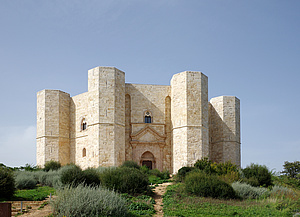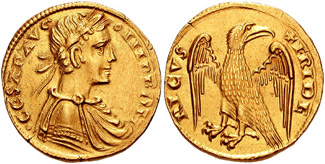Frederick II – Emperor, Antichrist, Astonishment of the World
![Friedrich II. mit seinem Falken. Aus seinem Buch De arte venandi cum avibus („Über die Kunst mit Vögeln zu jagen“), Süditalien zwischen 1258 und 1266. Città del Vaticano, Vatikanische Apostolische Bibliothek (Cod. Pal. Lat. 1071, fol. 1v), [WikiMedia Commons]](/fileadmin/_processed_/9/c/csm_Datei_Frederick_II_and_eagle_7a5785f248.jpg)
Frederic II (1194-1250) of Hohenstaufen was a fascinating and an influential ruler, whose life and work is being discussed controversially to this day. Even during his lifetime, assessment of his character and reign differed greatly. Some contemporaries called him „stupor mundi“ or “astonishment of the world”, while others did not view him that kindly, particularly the Popes of his time, who condemned him as a brute or even the Antichrist.
Frederick II was the last of the great Hohenstaufen Emperors and certainly one of the most dazzling characters of the 13th century. Frederick Barbarossa’s grandson spent his childhood in Sicily. In order to accept his inheritance, Frederick II set out towards Germany in 1212, accompanied by a small entourage. That same year he was crowned King at the Mainz Cathedral and he issued his first decree, the “Golden Bull of Sicily“, declaring Ottokar I and his heirs Kings of Bohemia. In 1220, eight years later, Frederick II returned to Italy and was crowned, in Rome’s St. Peter’s Basilica „Romanorum Imperator“, Holy Roman Emperor.

During the following 30 years of his imperial reign and fighting for dominance in Italy, Frederick II had to face the papacy as well as the increasing strength of North Italian cities. Indeed
Frederick II was no one to avoid conflict, neither on the intellectual, political nor military level. He ignored many social rules of his time, seemingly never siding with any “party”. On the crusade of 1229 he became the first medieval ruler to succeed in obtaining the release of Jerusalem in large parts from its Muslim conquerors without applying any force. Actually some sources report on Frederick II and Sultan al-Kamil becoming close friends: an early example of peaceful and fruitful exchange with the “strange Islamic culture of Islam”.

Frederick II could never be pigeonholed, neither then nor now. Passionate and coldly calculating, unmistakable and inconsistent, visionary and despotic – the Staufen Emperor embodied many aspects of human existence – although with unequalled greater demand and influence than the average medieval person. During his intense and quite multifaceted life Frederick II founded the University of Naples, authored a scientific treatise on falconry, spoke various languages, married four times and fathered more than a dozen children, including the offspring of his numerous extramarital affairs.
His documents mirror his reign while they also are signs of his Maiestas, his grandeur as ruler. In the High Middle Ages, these documents proved to be powerful media in the Emperor’s image campaign – with regard to the importance of their content as well as their design.
